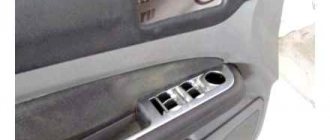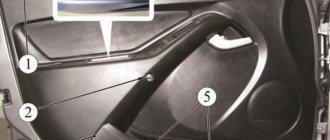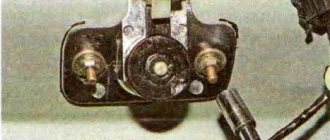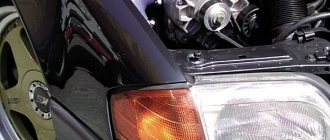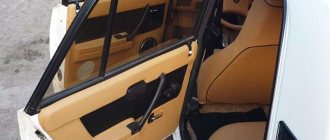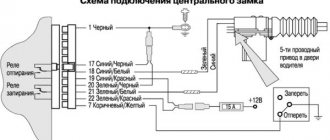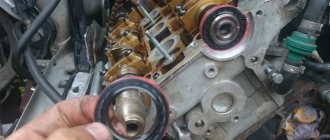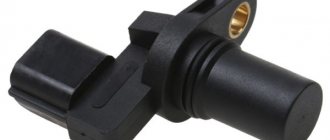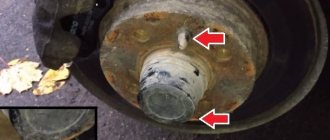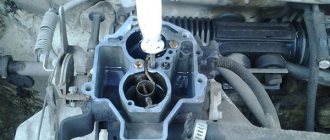The four-door VAZ 2110 sedan is the flagship model in the Lada 110 family. The last car rolled off the assembly line in 2007 after a twelve-year production cycle. The door trim of the VAZ 2110 is made of durable, hard plastic, the material is resistant to wear and mechanical damage.
The disadvantage of the door trim is the same type of texture and three types of colors; most drivers prefer to tune the interior and change the trim to a more modern material.
Replacement options
Drivers have several options for replacing door trim, each of which has its own advantages and is chosen based on taste:
- Eurocard;
- European cladding;
- panels from the manufacturer;
- independent re-upholstery.
Factory trims from AvtoVAZ are replacement kits for the original trim. They are made of plastic and additionally covered with decorative inserts. The advantages are the exact overall dimensions, ease of installation of clips, and compliance with the door dimensions. Frequently used sheathing kits Lux 1 or Lux 2.
With European cladding, the door lining is made of high-strength polymers and comes in a variety of colors. Manufacturers are small companies specializing in car tuning.
Self-upholstery does not require large investments and is within the capabilities of every driver. The material you can use is textiles, natural, artificial leather, velor, etc.
Tools and materials
To reupholster yourself you will need to prepare:
- Sheathing material.
Experienced drivers recommend using vinyl, but keep in mind that the material shrinks significantly. Before purchasing, you must take measurements and leave at least 10 cm for allowances and internal bends. If genuine leather or suede is used, allow up to 5 cm for allowances.
- Scissors with a long blade.
- Glue. For repairs they use Moment, Master, Titan.
- A construction knife with a small blade and a sharp end.
- Construction or household hair dryer. It is not recommended to use a heating lamp as it may deform the material.
- Glue brushes: thin, wide.
- Set of clips.
For the VAZ 2110 they produce special sets of fasteners, the cost of a set of 10 clips is 30 rubles. Each door will require 8 clips. It is recommended to buy latches with a reserve. During installation, several clips often break, since the fasteners are consumer goods and the quality of the fasteners is not regulated.
- Self-tapping screws. If you use independent re-upholstery of the cladding on the old casing, then use standard short self-tapping screws; when installing factory casing or Eurocard, purchase a set of long self-tapping screws.
- Crosshead screwdriver.
- A thin screwdriver with a wide blade.
Lux 2 panels and Euro casings have standard places for speakers with a diameter of 17 cm. If the standard Lada audio system has smaller speakers, then you will need to select it to fit the size of the hole or add a rubber or plastic insert to the part to fit the speaker tightly to the mesh.
Dismantling
At a service station, a mechanic spends no more than 15 minutes to disassemble door panels. Self-replacement will go quickly if you adhere to the order of work and do not change the sequence.
Front doors
The work algorithm for the front and rear doors of the VAZ 2110 is slightly different. Before work, you must disconnect the negative terminal from the battery. If the standard trim is reinstalled on the Euro trim, then it is necessary to remove the window lifter lever.
How to remove the front door trim of a VAZ 2110 step by step:
- Wrap the screwdriver in a rag or cover the tip with electrical tape.
- Using a screwdriver, press the trim of the window handle away from its socket.
- Guide the screwdriver so that the panel comes out of the grooves.
- Dismantle the cladding and remove the socket.
- Using a screwdriver, press out the lock of the driver's door armrest plug.
- Remove the clamp.
- Unscrew the two screws that hold the handle.
- Press the inner handle of the armrest, turn it up, and remove the part.
- Unscrew the screw that holds the mirror mechanism and remove it from the lever.
- Remove the two fastening clips from their seat and remove the triangular trim.
- Carefully slide the screwdriver under the panel and unfasten the 6 clips.
If the driver's or front passenger's door is equipped with a power window, then after removing the handle lock, you need to disconnect the plug.
Rear doors
The differences in work when removing the door trim are based on the fact that power windows are rarely installed for rear row passengers. Removal of the rear door trim is carried out in the following steps:
- Use a thin screwdriver to pry the trim on the door handle and remove the part from the grooves.
- Unscrew the two bolts located under the trim.
- Carefully move the handle to the side, remove it from its seat, and pull it out.
- Unscrew the three screws securing the lower rear door trim panel.
- Remove the bottom panel.
- Unscrew the latch blocking the door from the inside.
- Pry off the cladding panel with a screwdriver; you can use a wooden wedge, bend it back and snap off the fastener clips.
The plastic clips must be reinstalled with new ones when assembling the updated door card.
Door trims "Lux VAZ 2110-12" + mounts for 16 speakers
In previous entries I talked about the multiple preparation of doors and door cards (technical hole plugs, backlight lamps, ESP control unit). Today we will talk directly about installing the skins. I’ll be honest, the process of installing “Lux” cards was simply painful! The skins themselves are super, but the fastenings... I heard about the problems, prepared, tried them on, but so be it.
During hasty fittings I did not notice any serious problems. The discrepancies were not great, the largest “run-up” of the fastenings was about 4mm.
If we consider individual fixation points, these are all little things. But when you need to latch at once (all six pistons), then millimeter distortions result in very big problems. By the way, from the factory there are 8 clips per door, here on all cards there are fewer!
About the process
1) Selection of pistons, clips.
Euro, VAZ 2110 and Kalino piston (1), Lada Largus clip, prepared linings from modelin (2).
There are a huge number of them, but due to the peculiarities of the fastenings, only “herringbone” ones are normally suitable (1). Feature: inserted into the hole.
I liked the white ones from Priora and the yellow ones from Largus (2). At first I tried to remake the fastenings for them (grooves instead of holes).
I attached the clips, but later during the installation process they did not fit. It turned out that in addition to the shift to the right/left and up/down, there is a jamb with long fastenings (plastic platforms). Most of them are not pressed against the metal and remain at a distance, leaving no opportunity for the clip (Largus or Priors) to snap into place.
Further, the so-called “Euro pistons”
Stopped on them. Reviews about Euro pistons are good and the price is not high.
Made from normal materials, moderately soft and not hard. Compared to other options, they are dismantled with less effort, for example, from the same viburnum they simply cling tightly (there is a high risk of breaking off the soldered holders from the casing).
2) Accessories for assembly.
New (standard) internal velvets and a replacement for the original “fungi” - lock release button 21700-6105125-00 (Sold as a set, bushings 21700-6105129-00 are not needed). Taped corners of the rear doors.
Front door trims without holes and inserts into handrails. Old scratched handles had to be replaced on all doors.
3) About the nuances of assembly.
Everything is clear with the fastenings, there was a complete collapse. In addition, it was necessary to return the ten-point locking rods to their place; the priors have a different bend and length. The locks were installed from 2170 along with the rods!
From the priors above.
In general, the velvets snap in place normally, they rise a little at the edge due to the fact that they fit on the ring around the button (can be trimmed).
The handles are very tight in several places; I had to trim the hole to press it tightly to the card. The moving plastic parts were lubricated with Permatex white lithium grease, now when opening the doors there are no extraneous creaking sounds (door opening handles, pulls).
Everything else is good. The triangles fell into place.
Right and left sides.
In addition to the clip mounts, there are 12 places for self-tapping screws; I didn’t give them up. Extra fixation won't hurt! Bought from a hardware store, painted black. The original screws turned out to be short.
It looks great on the door and is not conspicuous.
4) The result of the work done.
Front pair of trims
Rear pair of trims
I'm happy with the result, it looks nice in black! I like it, but the process completely blew my mind due to problems with fastenings, I’m afraid that the next removal will not be the last for them...
5) Making spacers for 16th speakers. (No metal cutting)
Din Alpine SPG-17C2. I never purchased the component system, so I installed these. I have no experience and at first there were a lot of questions: “What’s better?”
Mounting options considered:
1) Screw it to the card. 2) Grid to the card, speaker to the metal to the door. 3) Grid to the card, speaker to the ring and to the door. 4) Podium to the door, then the door card and on top of the speaker + mesh.
After consulting, I chose the required installation method and made option No. 4.
Process
Initially I wanted to use the third example (grid to the card, speaker to the ring and to the door). Why the blanks were made:
Flat spacer ring.
It later became clear that this option has several shortcomings. It is better when there is no void between the speaker and the card, but with such rings you cannot achieve such a result. I'll explain why this happens. Firstly:
The “deluxe door card” cutout is not aligned with the standard hole in the metal. The speaker will be off to the side.
Secondly:
The plane of the map and the door are not parallel. The map is at an angle relative to the standard landing. Having assessed the current situation, we remake the spacers taking into account all the above nuances. Places for attaching the podium to the doors.
Threaded rivets
Alteration of “pieces of wood” to suit new conditions. I cut off all the protrusions on the round part.
I added a second detail - the base. The entire structure will be screwed through it and the misalignment will be compensated.
Trying it on, noted the position of the ring.
Grinding the ring (inclination of the card plane)
Assembly of podiums.
After multiple fittings, we twist both parts with glue and seal the remaining cavities. I had to drill out places in the wood for the bolts fastening to the door (the ring partially falls on them). My mistake... Well, the painting.
Finished rings!
To the car.
There is seam sealant between the metal and the spacer (visible in the photo), the bolts are tightened with a thread locker.
We screw Alpine SPG-17C2 on top of the entire “vegetable garden”.
All pressing parts are glued with bitoplast from STP (mesh-speaker, speaker-card, card-podium).
Bottom line: The speaker is firmly mounted to the door card via a wooden ring screwed directly to the door. Thus, the acoustics play into the closed volume of the door, and not under the trim, which has a positive effect on the sound quality of even such a budget set.
There are absolutely no parasitic vibrations from the door or trim! When the volume increases above average, extraneous sounds appear from the windows, side mirrors and tenth external metal handles (not euro). Everything is on the street side.
Previously carried out work: Gluing, sound insulation of door cards. Gluing the front doors stp aero + fiberglass plugs for technical holes in the doors.
Self-upholstery
Before directly reupholstering, it is recommended to check the condition of the inner door panel, remove pockets of corrosion, check or replace sound insulation, replace rubber seals, so the doors will open better. For VAZ 2110, the service life of door seals is up to 3 years. The process of re-covering a door part yourself step by step:
- Clean the outside of the card. You can sand it with fine-grain emery for better adhesion of glue and leather.
- Attach the door card to the material, cut around the perimeter, leaving at least 7 cm around the edges.
- Treat the outer surface with glue and the inside of the future cladding with glue. Apply glue according to the manufacturer's recommendations. If an adhesive composition is used, then after coating you need to wait up to 10 minutes.
- Place the vinyl on the door card, constantly heating the material with a hairdryer, and level the surface so that the leatherette fills all the curves of the part: the space for the speaker, for the central panel, the recesses for the handles.
- Cut out all the holes that are covered with vinyl in the door card from the center and not reaching the perimeter, carefully wrap it on the wrong side, making sure that the edges of the fold do not exceed 2-3 cm. Trim off the remaining vinyl.
- After gluing the card, trim off the remaining vinyl, leaving at least 3-5 cm on the inside of the card perimeter.
Tuning
After finishing removal, clean the cards from dust using a vacuum cleaner, and begin tuning yourself.
First of all, measure and cut the necessary “patterns” for all door cards, taking into account an allowance of 5 or even 7 centimeters for each side.
This is so that during the process of gluing the sheathing material you do not have to install patches or redo everything all over again.
The glue must be applied to the cards with brushes one at a time so that it has time to dry a little, but not dry out. Having coated the doors with glue, we proceed to the cut piece of vinyl or fabric, which we also coat with glue on the back side, and set aside for 10-15 minutes.
After this time, we proceed directly to gluing the upholstery to the door cards. Vinyl stretches well, filling door “cavities”, but for this it needs to be heated with a hair dryer and smoothed over each cavity and bulge with your hands, preferably with gloves. The edges need to be carefully folded inside out and trimmed.
We subject the remaining doors to the same procedure. In addition, it is advisable to paste the same material over other parts of the interior so that it is in the same style.
These include door handle inlays, the glove compartment lid (if you want to highlight it), triangles at the mirrors, and the top cover of the steering casing. In places of various fastenings, you need to cut small holes using a stationery knife.
When reinstalling, do not forget to replace damaged pistons.
Installation of a ready-made kit
Re-upholstering the cladding yourself does not always help save time or money. If you don’t have time to do this yourself, then you can use ready-made cladding.
The set of door elements Lux 2 from AvtoVAZ has additional sound insulation, a set of standard fasteners, mesh for speakers and screws. Installing a finished panel takes up to 20 minutes for an inexperienced driver. When choosing a casing, choose original replicas; if the set contains only four panels, then the speaker grids, caps and screws must be purchased separately.
The lower part of the door trim needs to be screwed in only with long screws; if the standard kit offers short ones, then you need to change the screws yourself.
Installation of Lux 2 cladding in steps:
- Remove the old card.
- Attach a new panel, check the gaps and the alignment of the fastener locations.
- If the car is equipped with a mechanical window lift, then the panel needs to be modified. Lux 2 does not have a hole for the handle of a mechanical lift.
- Secure the trim to the clips.
- Tighten all the bolts and secure the outer trim panels.
How is installation done?
Reupholstery begins with replacing the plastic latches from the previous set. In most cases, this procedure is carried out simply if a high-quality upholstery set is purchased. Even if the seller assures the buyer of the high quality of his products, it is best to disassemble the door first and go shopping for new upholstery with one of the stock clips. This will help you select the most similar fastening elements.
When disassembling, you must remember that the self-tapping screws on the VAZ 2110 trims are different. The mounting screws for the bottom of the trim are usually longer, so it is advisable to place them separately from other hardware. European panels can be secured with the same screws if they do not spoil the appearance of the updated upholstery.
The stock audio preparation of the VAZ 2110 provides openings for speakers with a diameter of 13 cm. This is a good reason to replace the speakers with new ones, since the old ones will spoil the overall appearance. Of course, they can be covered with black protective mesh caps if it is not possible to replace them with new ones.
When purchasing an upholstery kit, you need to consider the type of window regulators on your vehicle. The panels are different for power and manual windows. If your car has a manual type of lifts, and you were unable to find upholstery for such doors, reupholstering can still be done. To do this, you will need to slightly alter the trim panels by cutting out a small opening for the window lift handle.
This process is simple because the upholstery has a soft backing that can be cut through with a small knife. Don't forget to mark with a pencil. Remember that the hole must be smaller than the diameter of the handle. Otherwise, it will fall inside the casing.
Cost and types of finished skins
At a specialized service station, the cost of reupholstering a door trim starts from 3,000 rubles. excluding the cost of the door card. Depending on the model, in 2022 the following prices for ready-made kits for the VAZ 2110 will remain:
- factory replicas from AvtoVAZ and KAMAZ - from 2300 rubles;
- Luxury cladding panels – from RUB 3,200;
- door cards Lux 2 for 16.8 cm speaker – 3500 RUR;
- plastic trim linings - from 300 rubles. thing.
Clips and nets for speakers must be purchased separately.
Fastening
The cost of one door trim piston is from 3 rubles. AvtoVAZ produces plastic fasteners in its workshops. Product code 2108-6302015, 21080630201500, width, clip length 1.5 cm.
The mount has a simple shape and holds the door panel trim using a plastic skirt. The manufacturer claims high quality parts, but in practice, when disassembling the door card, two of the six required clips break. When installing Euro sheathing, on average one clip breaks, this is worth taking into account.
